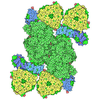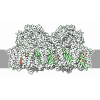[English] 日本語
 Yorodumi
Yorodumi- PDB-6jlu: Structure of PSII-FCP supercomplex from a centric diatom Chaetoce... -
+ Open data
Open data
- Basic information
Basic information
| Entry | Database: PDB / ID: 6jlu | |||||||||||||||||||||||||||||||||
|---|---|---|---|---|---|---|---|---|---|---|---|---|---|---|---|---|---|---|---|---|---|---|---|---|---|---|---|---|---|---|---|---|---|---|
| Title | Structure of PSII-FCP supercomplex from a centric diatom Chaetoceros gracilis at 3.02 angstrom resolution | |||||||||||||||||||||||||||||||||
 Components Components |
| |||||||||||||||||||||||||||||||||
 Keywords Keywords | PLANT PROTEIN / PSII-FCP supercomplex | |||||||||||||||||||||||||||||||||
| Function / homology |  Function and homology information Function and homology informationthylakoid / photosystem II assembly / photosystem II stabilization / photosystem II / extrinsic component of membrane / phosphate ion binding / chloroplast thylakoid membrane / photosynthesis, light reaction / photosynthesis / respiratory electron transport chain ...thylakoid / photosystem II assembly / photosystem II stabilization / photosystem II / extrinsic component of membrane / phosphate ion binding / chloroplast thylakoid membrane / photosynthesis, light reaction / photosynthesis / respiratory electron transport chain / electron transfer activity / protein stabilization / iron ion binding / heme binding Similarity search - Function | |||||||||||||||||||||||||||||||||
| Biological species |  Chaetoceros gracilis (Diatom) Chaetoceros gracilis (Diatom) | |||||||||||||||||||||||||||||||||
| Method | ELECTRON MICROSCOPY / single particle reconstruction / cryo EM / Resolution: 3.02 Å | |||||||||||||||||||||||||||||||||
 Authors Authors | Pi, X. / Zhao, S. / Wang, W. / Kuang, T. / Sui, S. / Shen, J. | |||||||||||||||||||||||||||||||||
 Citation Citation |  Journal: Science / Year: 2019 Journal: Science / Year: 2019Title: The pigment-protein network of a diatom photosystem II-light-harvesting antenna supercomplex. Authors: Xiong Pi / Songhao Zhao / Wenda Wang / Desheng Liu / Caizhe Xu / Guangye Han / Tingyun Kuang / Sen-Fang Sui / Jian-Ren Shen /   Abstract: Diatoms play important roles in global primary productivity and biogeochemical cycling of carbon, in part owing to the ability of their photosynthetic apparatus to adapt to rapidly changing light ...Diatoms play important roles in global primary productivity and biogeochemical cycling of carbon, in part owing to the ability of their photosynthetic apparatus to adapt to rapidly changing light intensity. We report a cryo-electron microscopy structure of the photosystem II (PSII)-fucoxanthin (Fx) chlorophyll (Chl) a/c binding protein (FCPII) supercomplex from the centric diatom The supercomplex comprises two protomers, each with two tetrameric and three monomeric FCPIIs around a PSII core that contains five extrinsic oxygen-evolving proteins at the lumenal surface. The structure reveals the arrangement of a huge pigment network that contributes to efficient light energy harvesting, transfer, and dissipation processes in the diatoms. | |||||||||||||||||||||||||||||||||
| History |
|
- Structure visualization
Structure visualization
| Movie |
 Movie viewer Movie viewer |
|---|---|
| Structure viewer | Molecule:  Molmil Molmil Jmol/JSmol Jmol/JSmol |
- Downloads & links
Downloads & links
- Download
Download
| PDBx/mmCIF format |  6jlu.cif.gz 6jlu.cif.gz | 2.2 MB | Display |  PDBx/mmCIF format PDBx/mmCIF format |
|---|---|---|---|---|
| PDB format |  pdb6jlu.ent.gz pdb6jlu.ent.gz | Display |  PDB format PDB format | |
| PDBx/mmJSON format |  6jlu.json.gz 6jlu.json.gz | Tree view |  PDBx/mmJSON format PDBx/mmJSON format | |
| Others |  Other downloads Other downloads |
-Validation report
| Arichive directory |  https://data.pdbj.org/pub/pdb/validation_reports/jl/6jlu https://data.pdbj.org/pub/pdb/validation_reports/jl/6jlu ftp://data.pdbj.org/pub/pdb/validation_reports/jl/6jlu ftp://data.pdbj.org/pub/pdb/validation_reports/jl/6jlu | HTTPS FTP |
|---|
-Related structure data
| Related structure data |  9839MC M: map data used to model this data C: citing same article ( |
|---|---|
| Similar structure data |
- Links
Links
- Assembly
Assembly
| Deposited unit | 
|
|---|---|
| 1 |
|
- Components
Components
-Protein , 14 types, 42 molecules AaBbCcDdEeGgPpRrVvWwZz010123456...
| #1: Protein | Mass: 39575.062 Da / Num. of mol.: 2 / Source method: isolated from a natural source / Source: (natural)  Chaetoceros gracilis (Diatom) Chaetoceros gracilis (Diatom)#2: Protein | Mass: 56475.301 Da / Num. of mol.: 2 / Source method: isolated from a natural source / Source: (natural)  Chaetoceros gracilis (Diatom) Chaetoceros gracilis (Diatom)#3: Protein | Mass: 49357.348 Da / Num. of mol.: 2 / Source method: isolated from a natural source / Source: (natural)  Chaetoceros gracilis (Diatom) Chaetoceros gracilis (Diatom)#4: Protein | Mass: 37983.301 Da / Num. of mol.: 2 / Source method: isolated from a natural source / Source: (natural)  Chaetoceros gracilis (Diatom) Chaetoceros gracilis (Diatom)#5: Protein | Mass: 9062.132 Da / Num. of mol.: 2 / Source method: isolated from a natural source / Source: (natural)  Chaetoceros gracilis (Diatom) Chaetoceros gracilis (Diatom)#7: Protein | Mass: 18733.262 Da / Num. of mol.: 2 / Source method: isolated from a natural source / Source: (natural)  Chaetoceros gracilis (Diatom) Chaetoceros gracilis (Diatom)#16: Protein | Mass: 24667.848 Da / Num. of mol.: 2 / Source method: isolated from a natural source / Source: (natural)  Chaetoceros gracilis (Diatom) Chaetoceros gracilis (Diatom)#18: Protein | Mass: 6230.672 Da / Num. of mol.: 2 / Source method: isolated from a natural source / Source: (natural)  Chaetoceros gracilis (Diatom) Chaetoceros gracilis (Diatom)#21: Protein | Mass: 14920.837 Da / Num. of mol.: 2 / Source method: isolated from a natural source / Source: (natural)  Chaetoceros gracilis (Diatom) / References: UniProt: B6ZHF4 Chaetoceros gracilis (Diatom) / References: UniProt: B6ZHF4#22: Protein | Mass: 5720.508 Da / Num. of mol.: 2 / Source method: isolated from a natural source / Source: (natural)  Chaetoceros gracilis (Diatom) Chaetoceros gracilis (Diatom)#25: Protein | Mass: 6417.546 Da / Num. of mol.: 2 / Source method: isolated from a natural source / Source: (natural)  Chaetoceros gracilis (Diatom) Chaetoceros gracilis (Diatom)#26: Protein | Mass: 18781.801 Da / Num. of mol.: 2 / Source method: isolated from a natural source / Source: (natural)  Chaetoceros gracilis (Diatom) Chaetoceros gracilis (Diatom)#27: Protein | Mass: 18988.840 Da / Num. of mol.: 16 / Source method: isolated from a natural source / Source: (natural)  Chaetoceros gracilis (Diatom) Chaetoceros gracilis (Diatom)#28: Protein | Mass: 18214.701 Da / Num. of mol.: 2 / Source method: isolated from a natural source / Source: (natural)  Chaetoceros gracilis (Diatom) Chaetoceros gracilis (Diatom) |
|---|
-Protein/peptide , 9 types, 18 molecules FfIiJjKkLlMmNnTtYy
| #6: Protein/peptide | Mass: 3652.377 Da / Num. of mol.: 2 / Source method: isolated from a natural source / Source: (natural)  Chaetoceros gracilis (Diatom) Chaetoceros gracilis (Diatom)#9: Protein/peptide | Mass: 3940.673 Da / Num. of mol.: 2 / Source method: isolated from a natural source / Source: (natural)  Chaetoceros gracilis (Diatom) Chaetoceros gracilis (Diatom)#10: Protein/peptide | Mass: 3487.078 Da / Num. of mol.: 2 / Source method: isolated from a natural source / Source: (natural)  Chaetoceros gracilis (Diatom) Chaetoceros gracilis (Diatom)#11: Protein/peptide | Mass: 4225.085 Da / Num. of mol.: 2 / Source method: isolated from a natural source / Source: (natural)  Chaetoceros gracilis (Diatom) Chaetoceros gracilis (Diatom)#12: Protein/peptide | Mass: 4367.076 Da / Num. of mol.: 2 / Source method: isolated from a natural source / Source: (natural)  Chaetoceros gracilis (Diatom) Chaetoceros gracilis (Diatom)#13: Protein/peptide | Mass: 4358.022 Da / Num. of mol.: 2 / Source method: isolated from a natural source / Source: (natural)  Chaetoceros gracilis (Diatom) Chaetoceros gracilis (Diatom)#14: Protein/peptide | Mass: 2571.161 Da / Num. of mol.: 2 / Source method: isolated from a natural source / Source: (natural)  Chaetoceros gracilis (Diatom) Chaetoceros gracilis (Diatom)#19: Protein/peptide | Mass: 3711.547 Da / Num. of mol.: 2 / Source method: isolated from a natural source / Source: (natural)  Chaetoceros gracilis (Diatom) Chaetoceros gracilis (Diatom)#24: Protein/peptide | Mass: 3634.343 Da / Num. of mol.: 2 / Source method: isolated from a natural source / Source: (natural)  Chaetoceros gracilis (Diatom) Chaetoceros gracilis (Diatom) |
|---|
-Photosystem II reaction center ... , 2 types, 4 molecules HhXx
| #8: Protein | Mass: 7188.501 Da / Num. of mol.: 2 / Source method: isolated from a natural source / Source: (natural)  Chaetoceros gracilis (Diatom) / References: UniProt: B7XBY7 Chaetoceros gracilis (Diatom) / References: UniProt: B7XBY7#23: Protein/peptide | Mass: 3502.219 Da / Num. of mol.: 2 / Source method: isolated from a natural source / Source: (natural)  Chaetoceros gracilis (Diatom) / References: UniProt: B6ZHF2 Chaetoceros gracilis (Diatom) / References: UniProt: B6ZHF2 |
|---|
-Extrinsic protein in photosystem ... , 3 types, 6 molecules OoQqUu
| #15: Protein | Mass: 26820.375 Da / Num. of mol.: 2 / Source method: isolated from a natural source / Source: (natural)  Chaetoceros gracilis (Diatom) / References: UniProt: B6ZHE8 Chaetoceros gracilis (Diatom) / References: UniProt: B6ZHE8#17: Protein | Mass: 22585.391 Da / Num. of mol.: 2 / Source method: isolated from a natural source / Source: (natural)  Chaetoceros gracilis (Diatom) / References: UniProt: B6ZHE9 Chaetoceros gracilis (Diatom) / References: UniProt: B6ZHE9#20: Protein | Mass: 10167.527 Da / Num. of mol.: 2 / Source method: isolated from a natural source / Source: (natural)  Chaetoceros gracilis (Diatom) / References: UniProt: B6ZHF0 Chaetoceros gracilis (Diatom) / References: UniProt: B6ZHF0 |
|---|
-Sugars , 1 types, 14 molecules 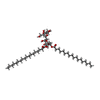
| #38: Sugar | ChemComp-DGD / |
|---|
-Non-polymers , 17 types, 523 molecules 

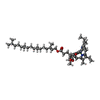

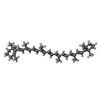
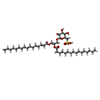
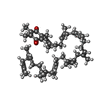
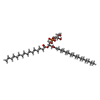
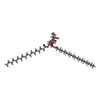

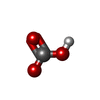

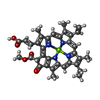
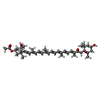



















| #29: Chemical | | #30: Chemical | #31: Chemical | ChemComp-CLA / #32: Chemical | ChemComp-PHO / #33: Chemical | ChemComp-BCR / #34: Chemical | ChemComp-SQD / #35: Chemical | ChemComp-PL9 / #36: Chemical | ChemComp-LHG / #37: Chemical | ChemComp-LMG / #39: Chemical | #40: Chemical | #41: Chemical | ChemComp-HEM / #42: Chemical | ChemComp-KC1 / #43: Chemical | ChemComp-A86 / ( #44: Chemical | #45: Chemical | ChemComp-KC2 / #46: Water | ChemComp-HOH / | |
|---|
-Details
| Has protein modification | Y |
|---|---|
| Sequence details | Complete sequence of entities Psb34, PsbR, PsbW and FCP-E are unknown. |
-Experimental details
-Experiment
| Experiment | Method: ELECTRON MICROSCOPY |
|---|---|
| EM experiment | Aggregation state: PARTICLE / 3D reconstruction method: single particle reconstruction |
- Sample preparation
Sample preparation
| Component | Name: PSII-FCP supercomplex / Type: COMPLEX / Entity ID: #1-#28 / Source: NATURAL |
|---|---|
| Source (natural) | Organism:  Chaetoceros gracilis (Diatom) Chaetoceros gracilis (Diatom) |
| Buffer solution | pH: 6.5 |
| Specimen | Embedding applied: NO / Shadowing applied: NO / Staining applied: NO / Vitrification applied: YES |
| Vitrification | Cryogen name: ETHANE |
- Electron microscopy imaging
Electron microscopy imaging
| Experimental equipment |  Model: Titan Krios / Image courtesy: FEI Company |
|---|---|
| Microscopy | Model: FEI TITAN KRIOS |
| Electron gun | Electron source:  FIELD EMISSION GUN / Accelerating voltage: 300 kV / Illumination mode: FLOOD BEAM FIELD EMISSION GUN / Accelerating voltage: 300 kV / Illumination mode: FLOOD BEAM |
| Electron lens | Mode: BRIGHT FIELD |
| Image recording | Electron dose: 50 e/Å2 / Film or detector model: GATAN K2 SUMMIT (4k x 4k) |
- Processing
Processing
| EM software |
| ||||||||||||
|---|---|---|---|---|---|---|---|---|---|---|---|---|---|
| CTF correction | Type: NONE | ||||||||||||
| Symmetry | Point symmetry: C2 (2 fold cyclic) | ||||||||||||
| 3D reconstruction | Resolution: 3.02 Å / Resolution method: FSC 0.143 CUT-OFF / Num. of particles: 42033 / Symmetry type: POINT |
 Movie
Movie Controller
Controller


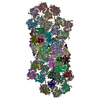


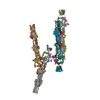

 PDBj
PDBj